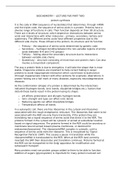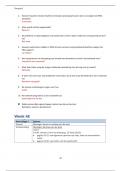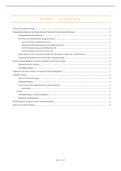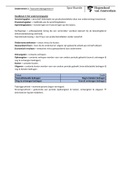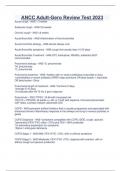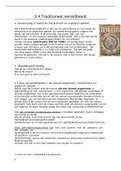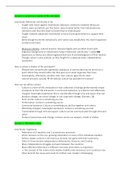BIOCHEMISTRY – LECTURE FIVE PART TWO
protein synthesis
It is the code in DNA (sequence of nucleotides) that determines, through mRNA
and the triplet code, the sequence of amino acids in a protein. Proteins have a
diverse range of functions in cells. Their function depends on their 3D structure.
There are 4 levels of structure, which depend on interactions between amino
acids and interactions with other molecules – primary, secondary, tertiary and
quaternary. The different amino acids have different properties due to the
different side chains. These influence the protein, its structure and its function.
Primary – the sequence of amino acids determined by genetic code
Secondary – hydrogen bonding between the non-variable regions of amino
acids (between N-H and C=O groups)
Tertiary – folding above the secondary structure due to interactions
between variable side chains
Quaternary – structure consisting of more than one protein chain. Can also
involve a non-protein component.
The way a protein folds is due to energetics; it will take the shape that is most
stable. Chaperone proteins are important to help correct folding in larger
proteins to avoid inappropriate interaction which could leave to dysfunction
(through inappropriate interact with other proteins for example). Aberrations in
protein folding are a hall mark of many diseases, especially neurodegenerative
diseases.
As the conformation (shape) of a protein is determined by the interactions
indicated (hydrogen bonds, ionic bonds, disulphide bridges etc.), factors that
disturb these bonds result in the protein losing its shape:
o pH affects protonation and disrupts hydrogen bonds
o Ionic strength and type can affect ionic bonds
o Reducing agents can affect disulphide bridges
o Temperature affects all bonds.
In a eukaryotic cell, there are free ribosomes in the cytosol and ribosomes
associated with the rough endoplasmic reticulum. The ribosomes that seem to be
associated with the RER are only there transiently, if the protein they are
translating has a signal sequence of amino acids that direct it to the RER. The
proteins formed in the cytosol will be cytosolic or aimed at subcellular location
based on signal sequences. The proteins formed in the RER could be secretory or
membrane bound (aimed toward plasma membrane, or destined for
endosomes/lysosomes). The ribosome/mRNA complex is cytosolic, until a
sequence of amino acids exits the ribosome. This is recognised by ‘Signal
Recognition Particle’ (SRP). This causes a pause in translation while the
ribosome/mRNA is translocated to the RER. When at the RER (and correctly
inserted) the SRP then dissociates and translation continues. Proteins formed at
the RER can be transported to the Golgi apparatus for modification and
subsequent transport.
Many proteins need non-protein groups added to them to be able to function.
Addition of sugars (glycosylation) is important for many protein involved cell
protein synthesis
It is the code in DNA (sequence of nucleotides) that determines, through mRNA
and the triplet code, the sequence of amino acids in a protein. Proteins have a
diverse range of functions in cells. Their function depends on their 3D structure.
There are 4 levels of structure, which depend on interactions between amino
acids and interactions with other molecules – primary, secondary, tertiary and
quaternary. The different amino acids have different properties due to the
different side chains. These influence the protein, its structure and its function.
Primary – the sequence of amino acids determined by genetic code
Secondary – hydrogen bonding between the non-variable regions of amino
acids (between N-H and C=O groups)
Tertiary – folding above the secondary structure due to interactions
between variable side chains
Quaternary – structure consisting of more than one protein chain. Can also
involve a non-protein component.
The way a protein folds is due to energetics; it will take the shape that is most
stable. Chaperone proteins are important to help correct folding in larger
proteins to avoid inappropriate interaction which could leave to dysfunction
(through inappropriate interact with other proteins for example). Aberrations in
protein folding are a hall mark of many diseases, especially neurodegenerative
diseases.
As the conformation (shape) of a protein is determined by the interactions
indicated (hydrogen bonds, ionic bonds, disulphide bridges etc.), factors that
disturb these bonds result in the protein losing its shape:
o pH affects protonation and disrupts hydrogen bonds
o Ionic strength and type can affect ionic bonds
o Reducing agents can affect disulphide bridges
o Temperature affects all bonds.
In a eukaryotic cell, there are free ribosomes in the cytosol and ribosomes
associated with the rough endoplasmic reticulum. The ribosomes that seem to be
associated with the RER are only there transiently, if the protein they are
translating has a signal sequence of amino acids that direct it to the RER. The
proteins formed in the cytosol will be cytosolic or aimed at subcellular location
based on signal sequences. The proteins formed in the RER could be secretory or
membrane bound (aimed toward plasma membrane, or destined for
endosomes/lysosomes). The ribosome/mRNA complex is cytosolic, until a
sequence of amino acids exits the ribosome. This is recognised by ‘Signal
Recognition Particle’ (SRP). This causes a pause in translation while the
ribosome/mRNA is translocated to the RER. When at the RER (and correctly
inserted) the SRP then dissociates and translation continues. Proteins formed at
the RER can be transported to the Golgi apparatus for modification and
subsequent transport.
Many proteins need non-protein groups added to them to be able to function.
Addition of sugars (glycosylation) is important for many protein involved cell

